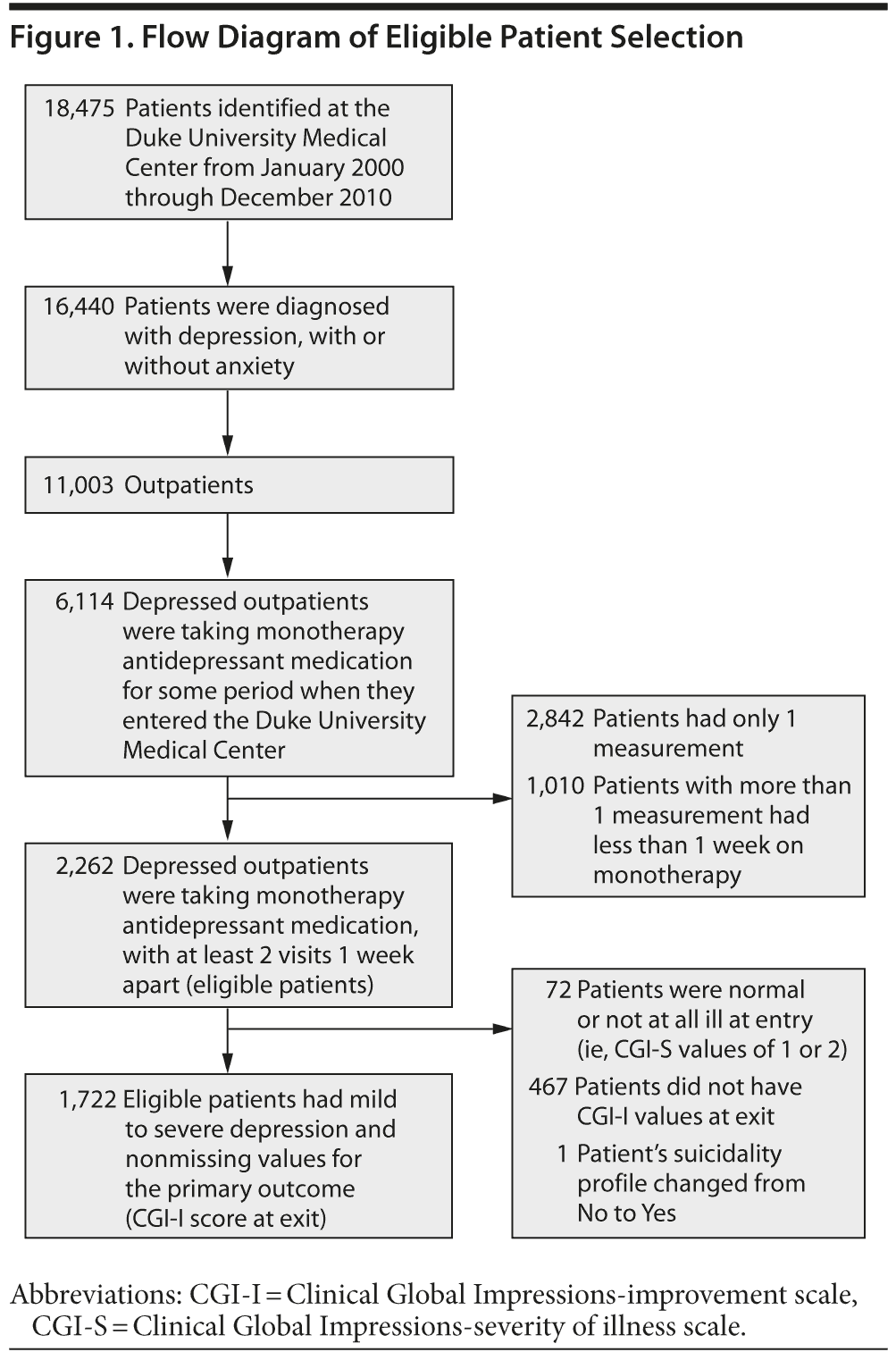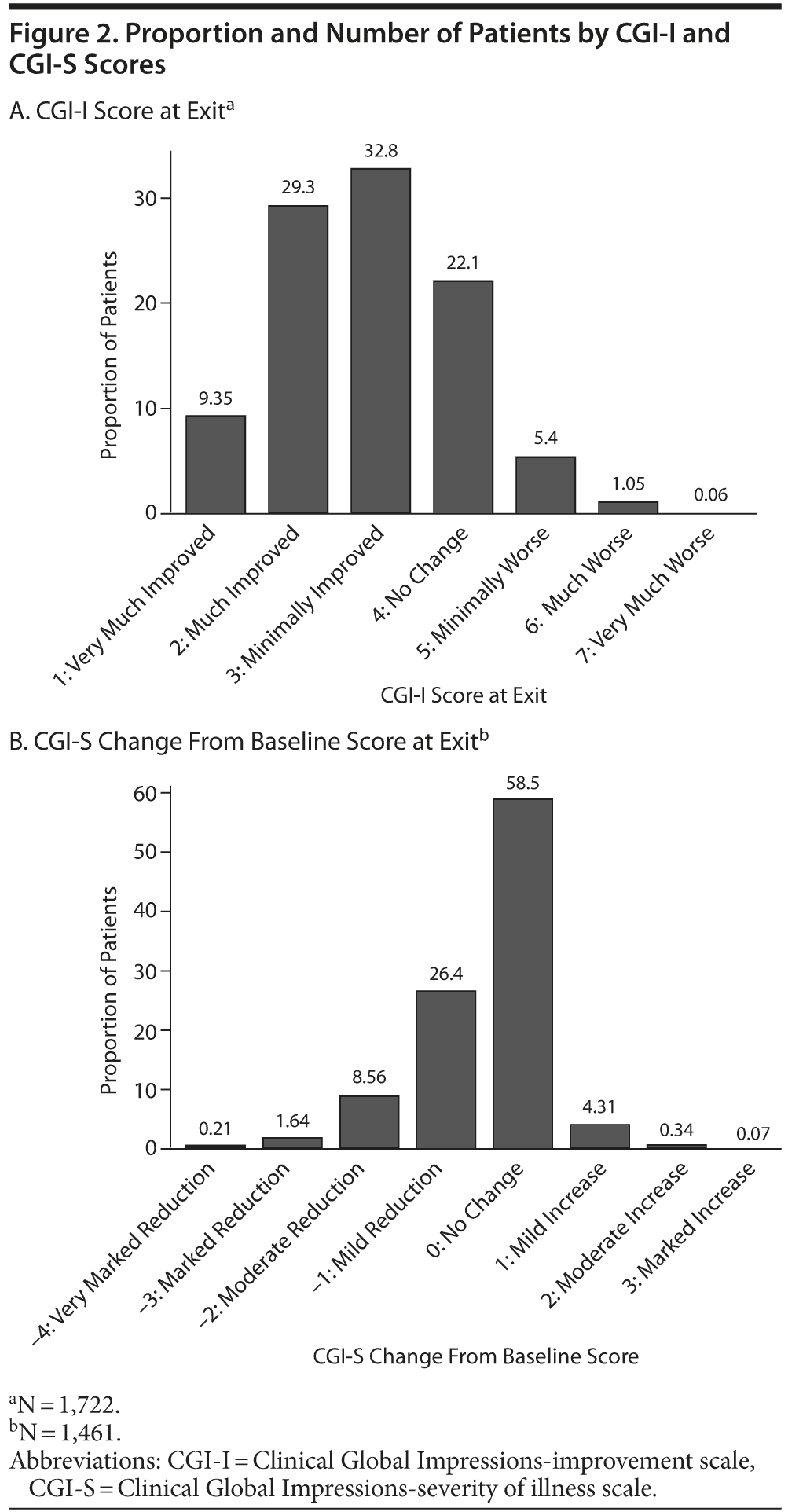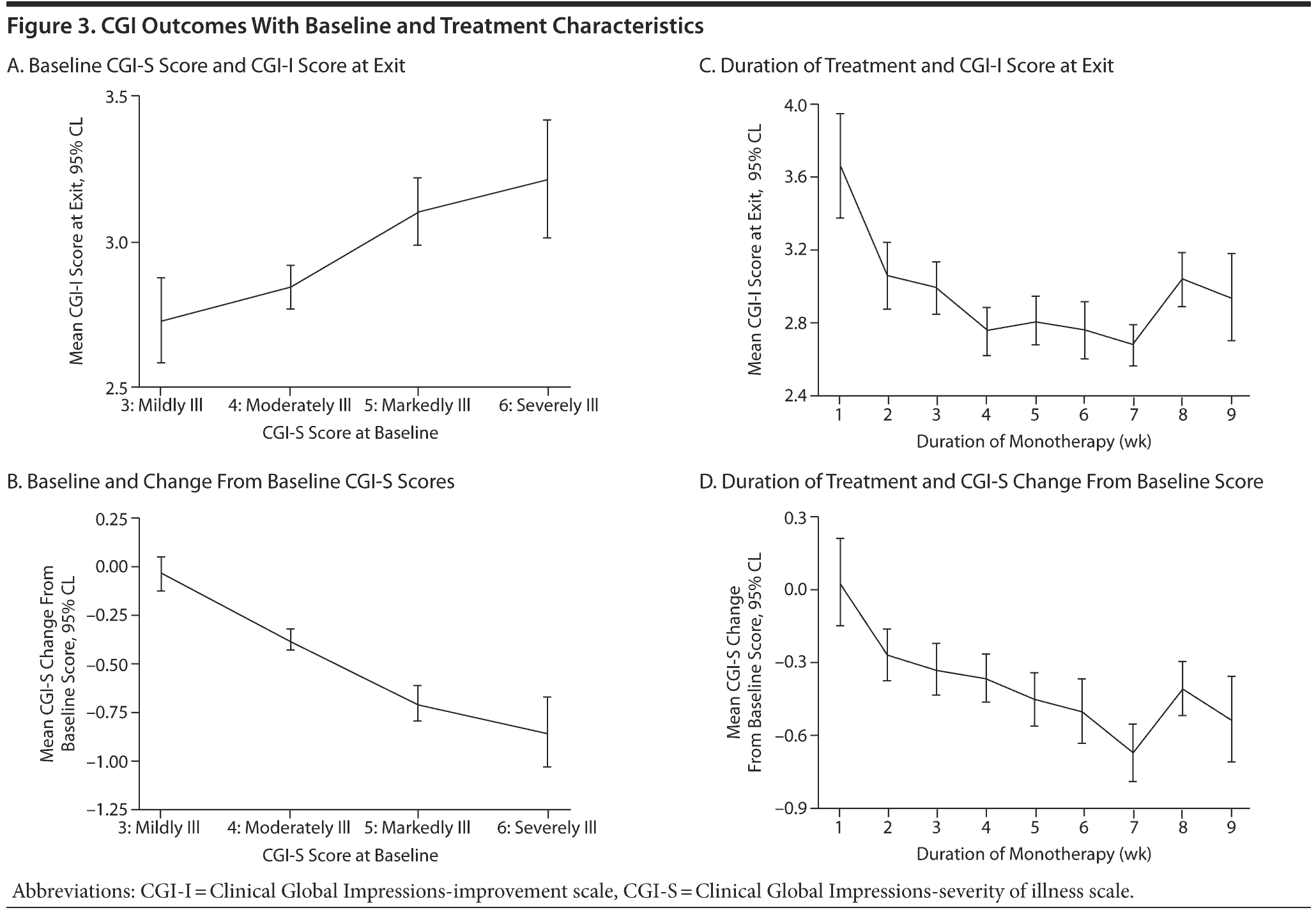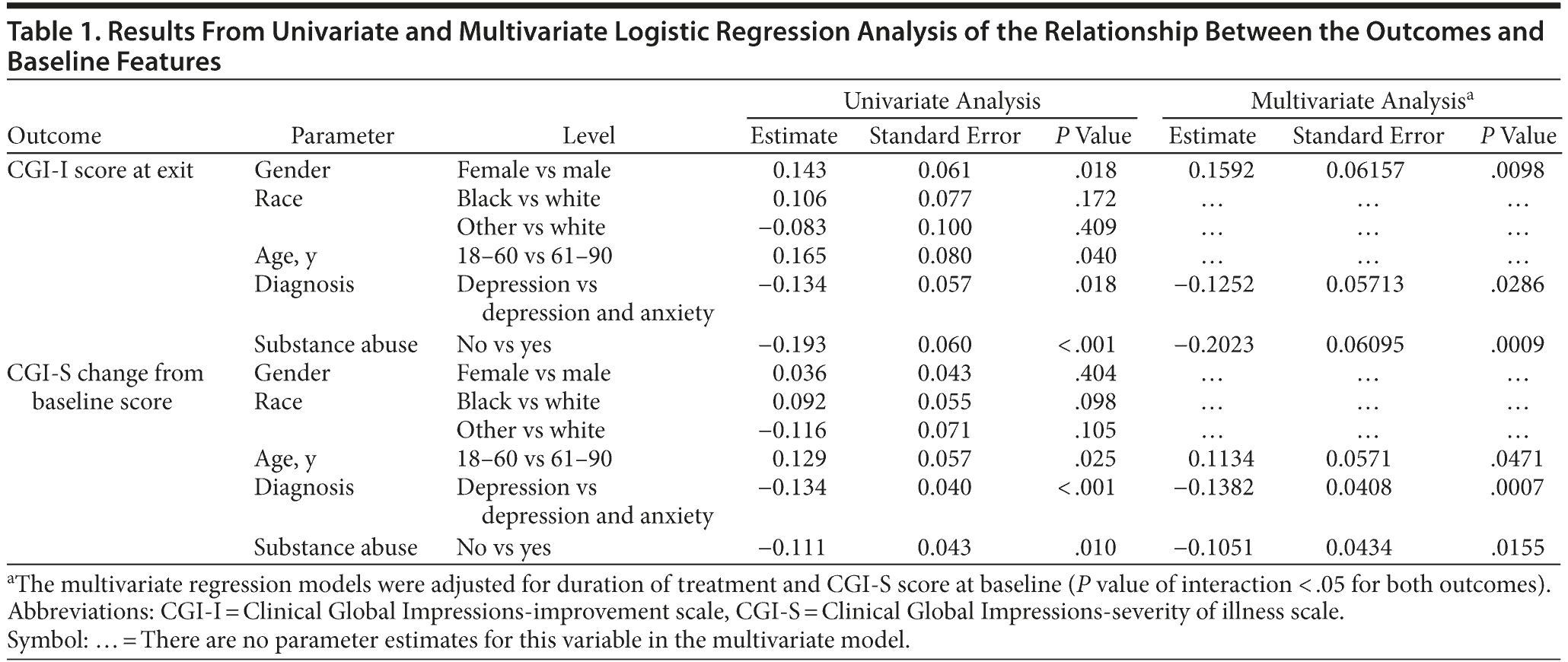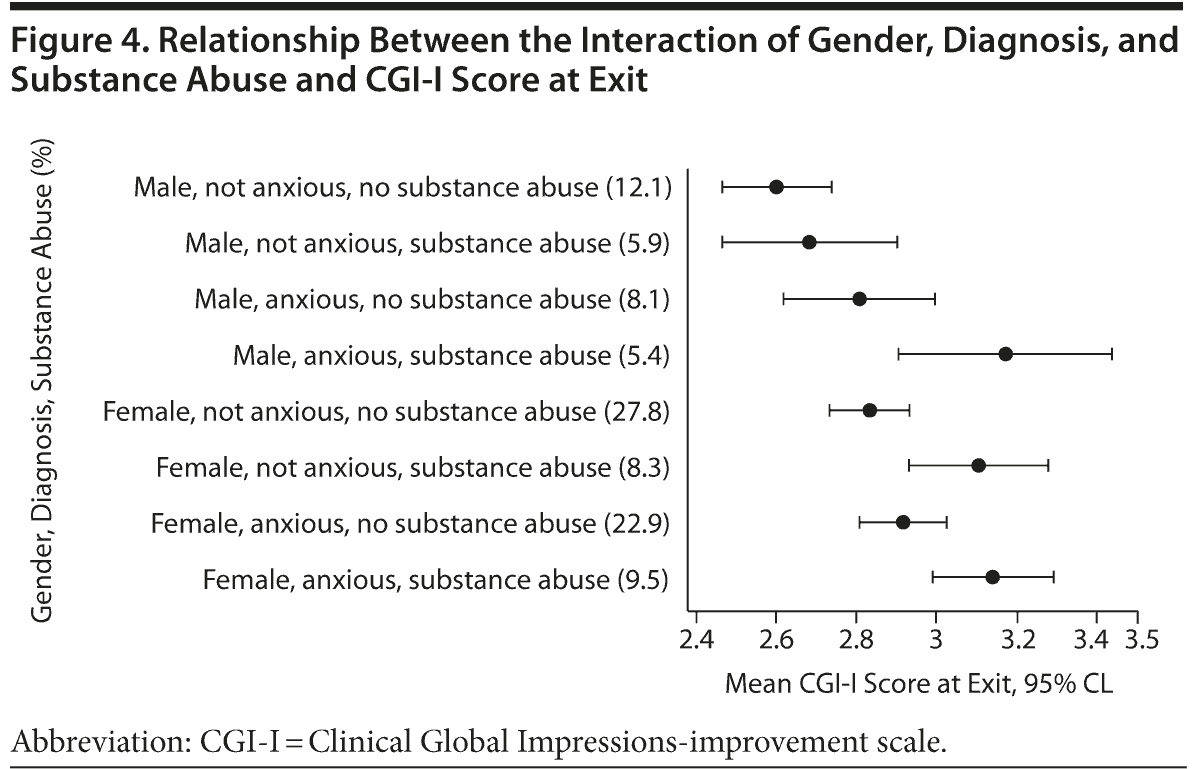The Effectiveness of Antidepressant Monotherapy in a Naturalistic Outpatient Setting

ABSTRACT
Objective: To assess a representative sample of clinically depressed outpatients during acute treatment with antidepressant medication monotherapy to determine clinical outcomes and evaluate relationships between outcomes and selected baseline/treatment features.
Method: This naturalistic study examined data on outpatients at the Department of Psychiatry, Duke University Medical Center, Durham, North Carolina, from January 2000 through December 2010. Eligible patients (N = 1,722) had a diagnosis of clinical depression (major depressive disorder, dysthymic disorder, or depressive disorder not otherwise specified as defined in DSM-IV-TR). Sociodemographic/clinical data were gathered at study entry (date of first treatment). The Clinical Global Impressions-improvement (CGI-I) and -severity of illness (CGI-S) scales were administered at entry and at study exit (end of follow-up) after 1 to 9 weeks of treatment. Analysis of variance, F tests, and t tests determined relationships between outcomes and treatment duration, baseline severity, and sociodemographic/clinical features.
Results: Thirty-nine percent of participants reported substantial improvement (CGI-I score = 1 or 2) from entry to exit, 33% reported minimal improvement (CGI-I score = 3), 22% reported no change, and approximately 7% reported worsened illness. Greater improvement (CGI-I score) and greater reduction in depressive severity (CGI-S score) were associated with greater baseline depressive severity and longer treatment duration (all P < .001). Participants with greater baseline depressive severity experienced larger reductions in depressive severity but reported worse CGI-I scores at exit. Less improvement in CGI-I scores was seen in women compared to men (P = .018). Less improvement in CGI-I scores and less reduction in CGI-S scores were seen in participants ≤ 60 years of age (P = .040 and P = .025, respectively) and those with comorbid substance abuse (P < .001 and P = .010, respectively) or anxiety (P = .018 and P < .001, respectively) disorders.
Conclusions: Most depressive symptom improvement occurred within the first 4 to 6 weeks of antidepressant monotherapy. Greater baseline severity, comorbid substance abuse, and comorbid anxiety disorders are associated with worse outcomes.
Prim Care Companion CNS Disord 2012;14(5):doi:10.4088/PCC.12m01364
© Copyright 2012 Physicians Postgraduate Press, Inc.
Submitted: February 14, 2012; accepted May 11, 2012.
Published online: October 4, 2012.
Corresponding author: Tih-Shih Lee, MD, PhD, Department of Psychiatry and Behavioral Science, Duke University Medical School, DUMC Box 3950, Durham, NC 27710 ([email protected]).
Clinical depression is a common disorder with high morbidity. The lifetime prevalence of depressive disorders in the United States is 16.5%.1 Initial treatment with an antidepressant medication monotherapy results in remission rates of 30% to 35%.2,3 Remission rates average 35% to 45% in randomized controlled trials4 that exclude patients who have a chronic course of depression or substantial general medical or psychiatric comorbidity. While double-blind, randomized controlled trials are the gold standard for establishing the efficacy of psychotropic medications, participants in the trials may not adequately represent patients who are seen by clinicians in practice. In fact, only a quarter of depressed patients in the pragmatic Sequenced Treatment Alternatives to Relieve Depression (STAR*D) trial would have been included in typical phase 3 registration trials for antidepressant medication.5
Such findings have led to concerns regarding the generalizability of the results of such clinical trials.6 While pragmatic trials like STAR*D are designed to be closer to naturalistic outpatient settings, they are still not fully representative of actual practice. In fact, STAR*D used a strict measurement-based-care approach to guide treatment by the clinicians,3 which seems to have resulted in the use of higher medication doses than are found in typical clinical care. Large-scale observational studies of antidepressant medications prescribed by practicing clinicians who are not guided in their care are likely more representative of typical clinical practice settings.
This naturalistic study examined a representative sample of outpatients with clinical depression (ie, major depressive disorder, dysthymic disorder, or depressive disorder not otherwise specified as defined in DSM-IV-TR) who were treated with antidepressant monotherapy. The objectives were to describe the overall response rates on the basis of Clinical Global Impressions-improvement (CGI-I) scale scores at exit and changes on the Clinical Global Impressions-severity of illness (CGI-S) scale7 from baseline to exit to investigate whether outcome was related to the duration of treatment or to baseline severity and to identify sociodemographic and clinical features that are associated with outcomes, while controlling for baseline depressive severity (CGI-S).
METHOD
Sample Selection
The study sample included outpatients at the Department of Psychiatry, Duke University Medical Center, Durham, North Carolina, who were treated from January 2000 through December 2010. Sociodemographic, clinical, and outcome information on these patients had been gathered using the MindLinc electronic medical record system (www.mindlinc.com, Durham, North Carolina). In order to facilitate research, MindLinc enforces a “qualified clinical visit,” which includes information regarding a patient’s medications, psychiatric diagnosis, side effects, billing codes, and CGI-I and CGI-S scores. This information is required from all clinical visits with a physician. Information in the data repository is anonymized and Health Insurance Portability and Accountability Act compliant and has been granted an institutional review board exemption for research.
The authors queried the data warehouse and retrieved the records of all adult outpatients (18 years of age or older at entry) who satisfied the following inclusion criteria: received a primary diagnosis by their clinician of clinical depression (major depressive disorder, dysthymic disorder, or depressive disorder not otherwise specified as defined in DSM-IV-TR), excluding bipolar or schizoaffective disorder; had complete CGI scores; and received up to 9 weeks of treatment. We henceforth refer to the end of follow-up as “exit.” The entry point for this study was the date of first treatment as recorded in MindLinc. Patients were not excluded due to other psychiatric comorbidities.

- A naturalistic study of antidepressant monotherapy showed that 39% of patients improved substantially.
- Greater initial depressive severity, comorbid substance abuse, and comorbid anxiety are associated with worse outcomes.
For patients who satisfied the inclusion criteria, we examined their records for the first 9 weeks of their antidepressant monotherapy treatment. Monotherapy treatment consisted of treatment with 1 of the following: a selective serotonin reuptake inhibitor (SSRI; citalopram, escitalopram, fluoxetine, paroxetine, or sertraline), a serotonin-norepinephrine reuptake inhibitor (SNRI; duloxetine or venlafaxine), or bupropion. Nine weeks was chosen as it is a common time interval used to estimate likely treatment benefit. Patients (and their entire record) were excluded from the sample if they dropped out of MindLinc within 1 week. The sample included patients who received any US Food and Drug-approved antidepressant medication at the time of treatment. A total of 1,722 eligible patients were identified out of 18,475 patients seen from January 2000 through December 2010 (Figure 1).
Measurement
While most clinical trials use the 17-item Hamilton Depression Rating Scale8 or the Beck Depression Inventory9 as a measure of response or remission, clinicians in naturalistic outpatient settings often make assessments of severity and improvement on the basis of their own impression of clinical improvement and on what the patients report, rather than on formal instruments. The CGI is a measure of clinician impressions regarding patient improvement and depressive severity. It has been shown to be a valid clinical outcome measure that is suitable for routine use.10 When comparing the Hamilton Depression Rating Scale, the Montgomery-Asberg Depression Rating Scale, and the CGI-S and CGI-I, Khan et al11 found that the 4 rating scales had similar effect sizes regardless of the antidepressant. Forkmann et al12 compared CGI-I scores and change of CGI-S scores and opined that the CGI-I was the preferred outcome measure. In this study, the primary outcome measure was the CGI-I score at exit. The secondary outcome measure was the change in CGI-S score at exit compared to entry. The CGI-I and CGI-S were completed by MD psychiatrists (46%), PhD psychologists (32%), and other allied health professionals (22%). There was no training, and no effort was made to establish interrater reliability.
The CGI-I is a 7-point scale that gathers the clinician’s direct assessment of the improvement or worsening of the patient’s illness relative to the patient’s condition at baseline, with a higher score indicating less improvement/greater worsening. The CGI-S is a 7-point scale that gathers the clinician’s assessment of the patient’s severity of illness, relative to the clinician’s past experience with patients who had the same diagnosis, with a higher score indicating greater severity. CGI-S change from baseline to exit is a 13-point scale that assesses the difference between the CGI-S score at exit and CGI-S score at entry. Negative values represent an improvement at exit compared to baseline, zero represents no change, and positive values represent worsening.
In this study, the CGI-S and CGI-I scores were required fields. The clinicians were required to enter these scores before they could terminate the visit, log out of the patient’s chart, and obtain reimbursement.
Statistical Method
Bar and line plots were used to depict outcome distributions and trends. Summary tables were used to describe the frequency and proportion of participants and the mean outcome and its corresponding 95% confidence limit by sociodemographic/clinical baseline features and antidepressant medications/classes. Analysis of variance, F tests, and t tests from general linear regression models13 were used to determine associations between the outcomes and baseline severity (CGI-S score at entry), duration of monotherapy, and sociodemographic/clinical baseline features, while adjusting for baseline severity and duration of monotherapy. Multiple comparisons were performed to identify subgroups associated with better/worse outcomes. The Tukey-Kramer method14 was used to adjust for multiple testing, correcting for the unbalanced number of participants in the various subgroups. Significance level, adjusted for multiple testing, was set at P < .05 unless stated otherwise. SAS version 9.2 software (SAS Institute, Cary, North Carolina) was used for the analyses.
RESULTS
A total of 1,722 patients met study eligibility criteria, of whom 68.5% were women and 74.9% were white, 15.7% were black, and 9.4% were classified as “other.” By age bands, 84% were aged 18 to 60 years and 13.7% were aged 61 to 90 years. In terms of diagnosis, 54.1% had clinical depression and 45.9 had clinical depression and comorbid anxiety disorder. Also, 21.4% of the participants had comorbid alcohol abuse, 2.9% had comorbid drug abuse, and 4.8% had comorbid drug and alcohol abuse. Due to the small number of those with comorbid drug abuse, alcohol and/or drug abuse were combined into a substance abuse category. Therefore, 29.1% reported comorbid substance abuse, and 70.9% reported no substance abuse.
The commonly used antidepressants in this sample were the SSRIs: sertraline (19.7%), escitalopram (12.4%), fluoxetine (12.2%), citalopram (10.4%), and paroxetine (7.7%); SNRIs: venlafaxine (11.4%) and duloxetine (6.6%); and bupropion (10.5%), each being received by at least 100 participants. All antidepressants that were received by more than 50 participants were generally useful on the basis of CGI score improvement at exit (upper limit of 95% CI < 4) and reduction in depressive severity at exit relative to baseline (upper limit of 95% CI < 0). Although no formal comparisons were performed due to the lack of randomization, the outcomes were similar for the different antidepressant medications. Selective serotonin reuptake inhibitors were by far the most-used antidepressant class (62.6%), followed by SNRIs (18.2%) and tricyclic antidepressants (3.2%). Participants in all antidepressant classes improved at exit, with some reduction in depressive severity relative to entry.
Thirty-nine percent of the participants had substantial improvement at exit (CGI-I score = 1 or 2), 33% had minimal improvement at exit (CGI-I score = 3), 22% had no change, and approximately 7% worsened relative to their state at entry (Figure 2A). Unlike the CGI-I scores at exit, the CGI-S change scores indicated that most of the participants had no change in depressive severity (59%), with only 10% experiencing at least a moderate reduction in depressive severity (CGI-S score ≤ −2) and approximately 5% progressing to a more severe state relative to their disease severity at entry (Figure 2B).
On average, the participants in all subgroups/levels of depressive severity at baseline seem to have experienced some level of improvement at exit (CGI-I score < 4). Those with lower depressive severity at baseline had lower CGI-I scores at exit (Figure 3A). Also, those with a greater baseline depressive severity had a greater reduction in depressive severity at exit (Figure 3B). Therefore, although participants with more severe scores at baseline experienced greater reductions in depressive severity, they still reported less improvement/greater worsening than did participants who were only mildly/moderately depressed at baseline.
Participants who had a longer duration of monotherapy had greater improvement (lower CGI-I values) at exit. The degree of improvement was proportional to the duration of monotherapy, but only until 4 weeks of treatment (Figure 3C). Beyond 4 weeks, no further improvement occurred. The same trend was observed after adjusting for depressive severity at baseline/entry. Similarly, participants with a longer duration of monotherapy experienced a proportional reduction in depressive severity (CGI-S change from baseline) only until 6 weeks of treatment. Beyond 6 weeks, no further reduction in depressive severity was observed (Figure 3D).
Results from regression models indicate that change in both the CGI-I and CGI-S from baseline was significantly associated with baseline depressive severity and duration of monotherapy (all P values < .001).
When each baseline feature was investigated separately (Table 1), we found that women experienced less improvement per the CGI-I compared to men (P = .018). Less improvement and less reduction in depressive severity were seen in younger participants (18-60 years of age, P = .040 and P = .025, respectively), participants who had comorbid substance abuse (P < .001 and P = .010, respectively), and participants who were diagnosed with comorbid anxiety (P = .018 and P < .001, respectively).
Investigation of the relationship between the outcomes and baseline features indicated that participant sex, substance abuse status, and the presence of a comorbid anxiety disorder affected the CGI-I score at exit and the CGI-S change from baseline to exit score. The 8 categories derived from participant sex, substance abuse status, and anxiety disorder status were compared on the basis of their mean CGI-I score at exit, while adjusting for multiple comparisons (Figure 4). The subgroups that benefited the least from treatment were men who had comorbid anxiety and comorbid substance abuse and women who had comorbid substance abuse and had or did not have comorbid anxiety. Results from multiple comparisons indicate that relative to the most improved subgroup (men without comorbid anxiety or substance abuse), significantly worse outcomes were seen for men with comorbid anxiety and substance abuse (difference between means = −0.5296, 95% lower confidence limit = −0.9646, 95% upper confidence limit = −0.0945); women with substance abuse and comorbid anxiety (difference between means = −0.4683, 95% lower confidence limit = −0.8411, 95% upper confidence limit = −0.0956); and women with substance abuse and no comorbid anxiety (difference between means = −0.4533, 95% lower confidence limit = −0.8343, 95% upper confidence limit = −0.0722).
DISCUSSION
Naturalistic studies on outcomes of antidepressant monotherapy aim to describe results from treatment in representative patients who are treated by usual care. These studies attempt to mirror naturalistic outpatient settings and so serve a complementary role to more structured efficacy trials and pragmatic studies of depression. The present naturalistic study, the first such study of antidepressant monotherapy outcomes to be conducted on a large scale, examined a representative sample of outpatients who had depression with or without anxiety and had received antidepressant monotherapy for 1 to 9 weeks. Thirty-nine percent responded substantially (much or very much improved) on the basis of the CGI-I, while only 10% responded substantially and 59% had no change in severity on the basis of a change in CGI-S score of −2 to −4 from baseline. Of the participants who responded to treatment, most did so by 4 to 6 weeks, with little improvement beyond 6 weeks. Participants who had comorbid anxiety disorders or had substance abuse disorders had a poorer response.
The discrepancy between the CGI-I and CGI-S may reflect the different constructs of these measures. In clinical trials, the CGI-I has been shown to be more closely correlated to changes in Hamilton Depression Rating Scale scores than is the CGI-S change from baseline.15 In naturalistic outpatient settings, the CGI-I may be more optimistic in that it reflects a broader view of the patient’s overall well-being. However, it may potentially reflect the wishful thinking of the clinician or the patient’s desire to please the clinician by giving a report of feeling better. The CGI-S is more directed at symptom severity. Moreover, in this study, the CGI-S at baseline and exit may not have been completed by the same rater. Given the discrepancy found between the CGI-I and CGI-S change from baseline, caution should be exercised in interpreting either measure in isolation.
As expected, we found that monotherapy outcomes were associated with the duration of monotherapy treatment. More importantly, this finding holds true even when adjustment is made for baseline severity. Most participants who responded received monotherapy treatment for 4 to 6 weeks, and those who received treatment for more than 6 weeks did not show further improvement. This finding suggests that clinicians should continue antidepressant monotherapy treatment for at least 6 weeks. If there is no response by 6 weeks, a reassessment may be warranted, possibly leading to a change in or augmentation with another antidepressant or other psychological or social intervention. The overall results for this study are roughly similar to those of STAR*D, though the rates of response are lower. In STAR*D’s first treatment level, nearly half of the participants responded to citalopram and approximately one-third did so only after 6 weeks. Thus, a significant number of participants did not benefit from antidepressant monotherapy.3
The broad lack of differences in responses between antidepressant monotherapies is consistent with the literature, which has not supported the use of one antidepressant more than another. It must be noted that this difference could not be assessed systematically because the present study was not a randomized study. Certain baseline features were found to be related to outcome. On the basis of CGI-I outcomes, men appear to have had more improvement than did women, and participants with a comorbid anxiety disorder or substance abuse disorder had less improvement than did those without. These findings corroborate the STAR*D findings that depressed patients who have comorbid anxiety and/or substance abuse disorders have worse pharmacologic treatment outcomes than do depressed patients who do not have these disorders. In STAR*D, those who endorsed both alcohol and drug use fared worst in terms of reduced rates of remission and increased time to reach remission.16 These subgroups may benefit from more aggressive and multifaceted treatment approaches.17,18 Our findings complement those of Ciudad et al19 who found that early response or remission are predictors of a good outcome of a major depressive episode. In their study of 930 patients, 38.2% showed early response and 20.5% showed early remission. Of the early responders, 76.1% had a 12-month good outcome as compared to 81.1% of early remitters.19
There are several limitations to this study. The results were from a single academic center, and the types of antidepressant monotherapies used represent only the practices in that 1 center; thus, the study has limited generalizability. This was a retrospective study with no randomization of antidepressant monotherapy assignment and no control for prestudy exposure to other medications. There was no adjustment for whether or not the participant had cognitive-behavioral or other psychological interventions. The anxiety disorders and substance abuse disorders were analyzed in broad categories. There were other potential confounders, such as physician or participant preferences regarding switching medications and discontinuation due to insurance reasons. The outcome measures employed, the CGI-I and CGI-S, are less structured and rely upon overall impressions by the clinicians, with potential problems such as interrater reliability, recall bias, wishful thinking, and patients trying to please the clinician by reporting better improvements than they are truly experiencing.
CONCLUSION
In a naturalistic setting, we found that almost 4 of 10 patients with depression benefited from antidepressant monotherapy. The vast majority of the benefit occurred within 4 to 6 weeks of treatment initiation. Those patients with greater baseline severity had greater improvement in depressive severity compared to those who were less severely ill, but they reported less improvement/greater worsening of depression from entry to exit. Other factors that were associated with worse outcome included the presence of comorbid anxiety disorders and substance abuse.
Drug names: bupropion (Wellbutrin, Aplenzin, and others), citalopram (Celexa and others), duloxetine (Cymbalta), escitalopram (Lexapro and others), fluoxetine (Prozac and others), paroxetine (Paxil, Pexeva, and others), sertraline (Zoloft and others), venlafaxine (Effexor and others).
Author affiliations: Department of Psychiatry, Duke University Medical School, Durham, North Carolina (Drs Lee, Gersing, Burchett, and Krishnan); Neuroscience and Behavioral Disorders Program (Drs Lee and Krishnan), Center for Quantitative Medicine (Drs Assam and Chan), and Office of Clinical Sciences (Dr Rush), Duke-NUS Graduate Medical School, Singapore; Singapore Clinical Research Institute, Singapore (Drs Assam, Chan, Krishnan, and Rush); Institute of Mental Health, Singapore (Drs Sim and Rush); and National University Health System, Singapore (Dr Feng).
Potential conflicts of interest: Since August 2010, Dr Rush has received consulting fees from University of Michigan and Brain Resource, consultant/speaker fees from Singapore College of Family Physicians, author royalties from Guilford Publications and University of Texas Southwestern Medical Center, and grant/research support from International College of Neuropsychopharmacology and National Institute of Mental Health. Dr Krishnan has served as a consultant to and is an indirect stockholder in Cenerx and is a stockholder in A2 Bioscience, Corcept, and Orexigen. Drs Lee, Assam, Gersing, Chan, Burchett, Sim, and Feng report no conflicts of interest related to the subject of this study.
Funding/support: This study was funded by a block grant to Duke-NUS Graduate Medical School from the Agency for Science, Technology and Research and the Ministry of Health, Singapore.
Role of sponsors: The funding agencies played no role in the design, implementation, and analysis of the study or in the decision to submit manuscripts for publication.
Acknowledgments: The authors acknowledge the editorial support of Jon Kilner, MS, MA, Pittsburgh, Pennsylvania, which was funded by a block grant to Duke-NUS Graduate Medical School from Agency for Science, Technology and Research and the Ministry of Health, Singapore.
REFERENCES
1. Kessler RC, Berglund P, Demler O, et al; National Comorbidity Survey Replication. The epidemiology of major depressive disorder: results from the National Comorbidity Survey Replication (NCS-R). JAMA. 2003;289(23):3095-3105. PubMed doi:10.1001/jama.289.23.3095
2. Clinical Practice Guideline Number 5. Chapter 5b: Treatment of Major Depression, Volume 2. AHCPR Publication No. 93-0551. National Library of Medicine (US). Health Services Technology Assessment Texts (HSTAT) Archive Collection. http://www.ncbi.nlm.nih.gov/books/NBK52234/. Updated April 1993. Accessed August 3, 2012.
3. Trivedi MH, Rush AJ, Wisniewski SR, et al; STAR*D Study Team. Evaluation of outcomes with citalopram for depression using measurement-based care in STAR*D: implications for clinical practice. Am J Psychiatry. 2006;163(1):28-40. PubMed doi:10.1176/appi.ajp.163.1.28
4. Fava M, Rush AJ, Trivedi MH, et al. Background and rationale for the Sequenced Treatment Alternatives to Relieve Depression (STAR*D) study. Psychiatr Clin North Am. 2003;26(2):457-494, x. PubMed doi:10.1016/S0193-953X(02)00107-7
5. Wisniewski SR, Rush AJ, Nierenberg AA, et al. Can phase III trial results of antidepressant medications be generalized to clinical practice? a STAR*D report. Am J Psychiatry. 2009;166(5):599-607. PubMed doi:10.1176/appi.ajp.2008.08071027
6. Zimmerman M, Mattia JI, Posternak MA. Are subjects in pharmacological treatment trials of depression representative of patients in routine clinical practice? Am J Psychiatry. 2002;159(3):469-473. PubMed doi:10.1176/appi.ajp.159.3.469
7. Guy W. Clinical Global Impression. ECDEU Assessment Manual for Psychopharmacology, Revised. US Dept Health, Education, and Welfare publication (ADM) 76-338. Rockville, MD: National Institute of Mental Health; 1976.
8. Hamilton M. A rating scale for depression. J Neurol Neurosurg Psychiatry. 1960;23(1):56-62. PubMed doi:10.1136/jnnp.23.1.56
9. Beck AT, Rush AJ, Shaw BF, et al. Cognitive Therapy of Depression. New York, NY: Guilford Press; 1979.
10. Berk M, Ng F, Dodd S, et al. The validity of the CGI severity and improvement scales as measures of clinical effectiveness suitable for routine clinical use. J Eval Clin Pract. 2008;14(6):979-983. PubMed doi:10.1111/j.1365-2753.2007.00921.x
11. Khan A, Khan SR, Shankles EB, et al. Relative sensitivity of the Montgomery-Asberg Depression Rating Scale, the Hamilton Depression Rating Scale and the Clinical Global Impressions rating scale in antidepressant clinical trials. Int Clin Psychopharmacol. 2002;17(6):281-285. PubMed doi:10.1097/00004850-200211000-00003
12. Forkmann T, Scherer A, Boecker M, et al. The Clinical Global Impression scale and the influence of patient or staff perspective on outcome. BMC Psychiatry. 2011;11(1):83. PubMed doi:10.1186/1471-244X-11-83
13. Kutner MH, Nachtsheim CJ, Neter J, et al. Applied Linear Statistical Models, 5th ed. Chicago, IL: McGraw-Hill/Irwin; 2004.
14. Kramer CY. Extension of multiple range tests to group means with unequal numbers of replications. Biometrics. 1956;12(3):307-310. doi:10.2307/3001469
15. Jiang Q, Ahmed S. An analysis of correlations among four outcome scales employed in clinical trials of patients with major depressive disorder. Ann Gen Psychiatry. 2009;8(1):4. PubMed doi:10.1186/1744-859X-8-4
16. Davis LL, Wisniewski SR, Howland RH, et al. Does comorbid substance use disorder impair recovery from major depression with SSRI treatment? an analysis of the STAR*D level one treatment outcomes. Drug Alcohol Depend. 2010;107(2-3):161-170. PubMed doi:10.1016/j.drugalcdep.2009.10.003
17. Friedman ES, Wisniewski SR, Gilmer W, et al. Sociodemographic, clinical, and treatment characteristics associated with worsened depression during treatment with citalopram: results of the NIMH STAR(*)D trial. Depress Anxiety. 2009;26(7):612-621. PubMed doi:10.1002/da.20568
18. Howland RH, Rush AJ, Wisniewski SR, et al. Concurrent anxiety and substance use disorders among outpatients with major depression: clinical features and effect on treatment outcome. Drug Alcohol Depend. 2009;99(1-3):248-260. PubMed doi:10.1016/j.drugalcdep.2008.08.010
19. Ciudad A, ×lvarez E, Roca M, et al. Early response and remission as predictors of a good outcome of a major depressive episode at 12-month follow-up: a prospective, longitudinal, observational study. J Clin Psychiatry. 2012;73(2):185-191. PubMed doi:10.4088/JCP.10m06314
